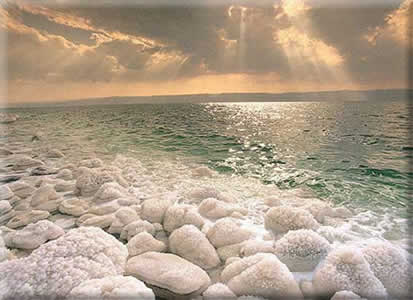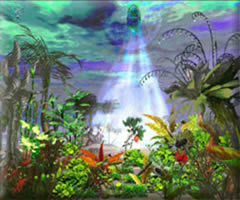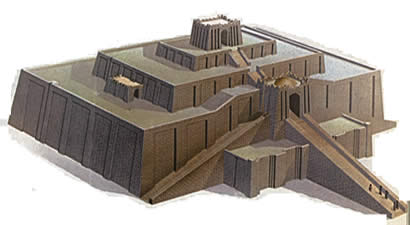The Forbidden Legacy of a Fallen Race
Part 1 | Part 2 | Part 3

Since the Enochian and Dead Sea literature was written by olive-skinned Jews of the post-exilic period, it is quite clear they were reciting traditions concerning a completely different race from a completely different climate. So who were these human angels, and where might they have lived?
Since we now know that the legends of the fall of the angels most probably originated in Iran, more precisely in the north-western kingdom of Media (modern-day Azerbaijan), then there is every reason to associate these traditions with the mountains beyond Media. This is tentatively confirmed by another Dead Sea text entitled the Genesis Apocryphon which records that after his ascent to heaven the patriarch Enoch spent the rest of his life "among the angels" in "paradise". Although the term "paradise" is used in some translations of the original text, the actual word is "Parwain".
I was therefore quite stunned to find that among the ancient traditions of the Mandaeans, a Magi-linked religion found mostly among the Marsh Arabs of Lower Iraq, "Parwan" is a holy mountain apparently located in the vicinity of Media in northwestern Iran. Furthermore, both "Parwan" and "Parwain" would appear to derive their root from the old Median word "Parswana", meaning "rib, side, frontier", used to describe the peoples and territories beyond the borders of Media.
These would have included the region of Parsa to its south and, more significantly, the mountainous region known as Parsua to its west.
Was Enoch therefore believed to have lived "among the angels" in the harsh mountainous territories beyond the limits of the ancient kingdom of Media? In the remote region of Parsua, to the west of Media, perhaps? Is this where the Watchers came from? Is it from here that they descended on to the plains to take mortal wives and reveal the forbidden arts and secrets of heaven?
In Iranian tradition the realm of the immortals and the seat of the mythical godkings of Iran (who like the fallen race of Judaic tradition were said to have been tall in stature with ivory white skin and shining countenances), was known as the Airyana Vaejah, the Iranian Expanse. Traditions fostered by the Magi imply quite clearly that this ethereal domain was located among the mountains of Media.
All roads appeared to lead to the mountainous region of modern-day Azerbaijan, which forms the eastern-most flanks of a vast snow-capped expanse that stretches west to the Taurus mountains of eastern Anatolia and northern Syria; north to the remote regions of Russian Armenia; and south-east along the length of the Zagros mountains, as they gradually descend towards the Persian Gulf and act as a virtually impenetrable barrier between Iraq and Iran.
This enormous, mostly desolate part of the earth, home in the most part to wandering nomads, bands of warring rebels, isolated religious communities and the occasional village, town or city, is known to the world as Kurdistan - the cultural and political homeland of the much troubled Kurdish peoples.
Yet according to biblical and apocryphal tradition, it was here also that the Garden of Eden, the resting place of Noah’s Ark and the stomping ground of the early patriarchs could be found. It was here too that I now realised I would have to go in search of the realm of the immortals.
Eastwards, in Eden
 The Book of Genesis speaks of God establishing a garden "eastwards, in Eden". Here Adam and Eve became humanity’s first parents before their eventual fall from grace through the beguiling of the subtle Serpent of Temptation. Serpents were not only a primary synonym for the Watchers and Nephilim, but the Book of Enoch even states which "Serpent", or Watcher, led our first parents into temptation. Interestingly enough, the Bundahishn, a holy text of the Zoroastrian faith, cites Angra Mainyu, the Evil Spirit and father of the daevas, as assuming this same role, and like the Watchers he too is described as a serpent with "legs". The Book of Genesis speaks of God establishing a garden "eastwards, in Eden". Here Adam and Eve became humanity’s first parents before their eventual fall from grace through the beguiling of the subtle Serpent of Temptation. Serpents were not only a primary synonym for the Watchers and Nephilim, but the Book of Enoch even states which "Serpent", or Watcher, led our first parents into temptation. Interestingly enough, the Bundahishn, a holy text of the Zoroastrian faith, cites Angra Mainyu, the Evil Spirit and father of the daevas, as assuming this same role, and like the Watchers he too is described as a serpent with "legs".
So where was Eden? All we know is that it was situated among the Seven Heavens, a paradisical realm with gardens, orchards and observatories in which the angels and Watchers reside in the Book of Enoch.
The word ‘Eden’ is translated by Hebrew scholars as meaning ‘pleasure’ or ‘delight’, a reference to the fact that God created the garden for the pleasure of mankind. This is not, however, its true origin. The word ‘Eden’ is in fact Akkadian - the proto-Hebrew, or Semitic, language introduced to Mesopotamia (modern-day Iraq) by the people of Agade, or Akkad, a race that seized control of the ancient kingdom of Sumer during the second half of the third millennium BC. In their language the word ‘Eden’, or edin, meant a ‘steppe’ or ‘terrace’, as in a raised agricultural terrace.
Turning to the word ‘paradise’, I found that this simply inferred a ‘walled enclosure’, after the Persian root pairi, ‘around’, and daeza, ‘wall’. It is a late-comer to Judaeo-Christian religious literature and was only really used after the year 1175 AD.
The English word ‘heaven’, on the other hand, is taken from the Hebrew ha’shemim, interpreted as meaning ‘the skies’. It can also refer to ‘high places’, such as lofty settlements. Moreover, the Hebrew word-root shm can mean ‘heights’, as well as ‘plant’ or ‘vegetation’, implying perhaps that the word ‘heaven’ might be more accurately translated as a ‘planted highlands’.
This quick round of simple etymology, in my opinion at least, conjured the image of a walled, agricultural settlement with stepped terraces placed in a highlands region. So is this what Eden was - a ‘walled, agricultural settlement’ placed among the mountains of Kurdistan? Had it been tended by angels under the dominion of the heavenly Watchers as is suggested by the text of the Book of Enoch? More importantly, where had it been located?
The Rivers of Paradise
The Book of Genesis says that from Eden stemmed the headwaters of the four rivers of paradise. The names of these are given as the Pishon, Gihon, Hiddekel and Euphrates. Of these four, only the last can properly be identified by name. The Euphrates flows through Turkish Kurdistan, Syria and Iraq before emptying into the Persian Gulf. The other three were identified by early biblical scholars respectively with the Ganges of India (although occasionally the Orontes of northern Syria), the Nile of Africa and the Tigris of western Asia, which, like its sister river the Euphrates flows through Iraq and empties into the Persian Gulf. The first two were chosen as suitable substitutes simply because they were looked upon by scholars as the mightiest rivers of the classical world; only the connection between the Hiddekel and the Tigris made any sort of geographical sense.
In no way could it be said that all four of these rivers rose in the same geographical region, a problem that was conveniently overlooked by theologians before the re-discovery of cartography in the sixteenth century. Other sources, particularly the Armenian Church, accepted the Euphrates and Tigris as two of the four rivers of paradise, yet chose to associate the other two, the Pishon and Gihon, with, respectively, the Greater Zab, which rises in Turkish Kurdistan and empties into the Tigris, and the Araxes, which rises in Armenia and empties into the Caspian Sea.
Had the Armenian Church been right to do this? Possibly yes, as they were the inhabitants of the geographical region in question and may well have been privy to local traditions unavailable to the outside theological world.
Whatever the identities of the four rivers of paradise, Kurdish tradition places their headwaters in the vicinity of Lake Van, an enormous inland sea - some 60 miles across and around 35 miles wide - situated on the border between Turkish Kurdistan and Armenia. Indeed, legend records that the Garden of Eden now lies ‘at the bottom of Lake Van’, after it was submerged beneath the waves at the time of the Great Flood.
Curiously enough, it is the mountain of Cudi Dag, or Mount Judi, south of Lake Van that the Moslems as well as the various different faiths of Kurdish extraction locate the so-called Place of Descent, the site where Noah’s Ark came to rest after the Great Flood. The attribution of this very same location with the more familiar Mount Ararat is a pure Christian invention that has no real basis in early religious tradition.
All this therefore implied that the compilers of the Book of Genesis placed both the birth-place of humanity, i.e. the Garden of Eden, and its point of regeneration after the Great Flood in the same general region of northern Kurdistan, surely a clue to the fact that the key to the origins of the Watchers lay in this same geographical area of the map.
The Heavenly Mountain
There is much more, however, for it is not just the Iranian and Jewish races that cite Kurdistan as the cradle of civilisation. The mythologies of both the Sumerians, who ruled the various Mesopotamian city-states from around 3000 BC onwards, and their eventual conquerors, the Akkadians, placed the homeland of the gods in this exact same region. The Akkadians originated as a Semitic, or proto-Hebrew, race of uncertain origin, and in their religious literature this heavenly abode is referred to as Kharsag Khurra, the heavenly mountain. Here the gods, also known as the Anannage, lived in a paradisical realm with gardens, orchards, temples and irrigated fields that not only resemble the Seven Heavens described in the Book of Enoch, but is actually referred to on more than one occasion as edin, the Akkadian for ‘steppe’ or ‘plateau’.
Even further linking Kharsag with the Jewish domain of angels is the knowledge that the Anannage, like the Enochian Watchers, were governed by a council of seven. These undoubtedly equate with the seven archangels of post-exilic Judaism as well as the six so-called Amesha Spentas, or ‘bounteous spirits’, who with the supreme god Ahura Mazda, preside over the angelic hierarchies in Iranian tradition.
Were the Anannage, the gods and goddesses of Kharsag, simply another form of the Watchers of Enochian and Dead Sea literature, whose homeland was a lofty agricultural settlement called Eden or heaven, located somewhere amid the mountains of Kurdistan?
The Search for Dilmun
Kharsag is not the only name used by the ancient Mesopotamians to refer to their place of first beginnings. This cradle of civilisation was also known by the name Dilmun, or Tilmun. Here, it was said, the god Ea and his wife were placed to institute "a sinless age of complete happiness". Here too animals lived in peace and harmony, man had no rival and the god Enlil "in one tongue gave praise". It is also described as a pure, clean and "bright" "abode of the immortals" where death, disease and sorrow are unknown and some mortals have been given "life like a god", words reminiscent of the Airyana Vaejah, the realm of the immortals in Iranian myth and legend, and the Eden of Hebraic tradition.
Although Dilmun is equated by most scholars with the island of Bahrain in the Persian Gulf, there is evidence to suggest that a much earlier mythical Dilmun was located in a mountainous region beyond the plains of Sumer. But where exactly was it located?
Mesopotamian inscriptions do not say; however, the Zoroastrian Bundahishn text and the Christian records of Arbela in Iraqi Kurdistan both refer to a location named Dilamвn as having existed around the headwaters of the Tigris, south-west of Lake Van - the very area in which the biblical Eden is said to have been located.
Furthermore, Ea (the Akkadian Enki) was said to have presided over the concourse of Mesopotamia’s two greatest rivers - the Tigris and Euphrates - which are shown in depictions as flowing from each of his shoulders. This would have undoubtedly have meant that the head-waters, or sources, of these rivers would have been looked upon as sacred to Ea by the cultures of Mesopotamia’s Fertile Crescent.
More curious is the knowledge that, as in Hebrew and Iranian myth, there would appear to have been a fall of the gods of Anu, the Anannage. Whilst 300 of their number remained in heaven, some 600 others, under the leadership of Nergal, god of the underworld, settled among mortal kind. Here they provided mankind with everything from basic agriculture, to astronomy, land irrigation, building technology and structured society.
Sounds familiar?
These rebel Anannage lived "in the earth", a reference to an "underworld" realm connected with the ancient city of Kutha, north of Babylon. In this "House of Darkness" lived "demons" and Edimmu, giant blood-sucking vampires who would return to the surface world after dark to steal the souls of the undead.
Could these infernal beings be a distorted memory of the rebel Watchers and their monstrous offspring, the Nephilim? Might these fallen angels have lived in underground cities after their descent on to the plains?
The Bodies of Birds
Ancient Mesopotamia fathered whole pantheons of devils and demons - each class having its own appearance, functions and attributes. Some were beneficial to mankind, while others caused only pain, suffering and torment in the mortal world.
In the story of the goddess Ishtar’s descent to the underworld, preserved in Assyrio-Babylonian tradition, the "chiefs" of the "House of Darkness" were said to have been "like birds covered with feathers", who "from the days of old ruled the earth, (and) to whom the gods Anu and Bel have given terrible names". In one cuneiform tablet written in the city of Kutha by a scribe "in the temple of Sitlam, in the sanctuary of Nergal" it describes the incursions into Mesopotamia of a race of demons, fostered by the gods in some nether region. They are said to have waged war on an unnamed king for three consecutive years and to have had the appearance of:
Men with the bodies of birds of the desert, human beings with the faces of ravens,these the great gods created, and in the earth the gods created for them a dwelling...in the midst of the earth they grew up and became great, and increased in number, Seven kings, brothers of the same family, six thousand in number were their people.
These "men with the bodies of birds" were looked upon as "demons". They would appear only once a storm-cloud had consumed the deserts and would slaughter those whom they took captive, before returning to some inaccessible region for another year.
There seems every reason to suggest that these fierce "demons" were not incorporeal spirits at all, but beings of flesh and blood adorned in cloaks of feathers and bird paraphernalia.
But who were these human demons, and how did they relate to the development of civilisation in Mesopotamia?
Uncertain Forces
The Sumerians were a unique people with their own language and culture. Nobody knows their true origin or where exactly they may have obtained the seeds of knowledge that helped establish the various city-states during the fourth millennium BC. Yet the Sumerians themselves were quite explicit on this point. They said their entire culture had been inherited from the Anannage, the gods of Anu, who had come from an ancestral homeland in the mountains. To emphasise this point they used an ideogram of a mountain to denote "the country", i.e. Sumer, and built seven-tiered ziggurats in honour of these founder gods.

Was it possible therefore that the proposed Watcher culture of Kurdistan provided the impetus for the rise of western civilisation?
Archaeologists have no problem accepting Kurdistan as the cradle of Near Eastern civilisation. Shortly after the recession of the last Ice Age, c.8500 BC, there emerged in this region some of the earliest examples of agriculture, animal domestication, baked and painted pottery, metallurgy and worked obsidian tools and utensils. Curiously enough, from c.5750 BC onwards for several hundred years the trade in raw and worked obsidian throughout Kurdistan seems to have been centred around an extinct volcano named Nemrut Dag on the south-western shores of Lake Van, the very area in which both the mythical lands of Eden and Dilmun are likely to have been located.
Kurdistan was undoubtedly the point of origin of the so-called Neolithic explosion from the ninth millennium BC onwards. Indeed, it is because of this settled community lifestyle in Kurdistan that the earliest known form of token bartering developed. This primitive method of exchange eventually led to the establishment of the first written alphabet and ideogram system on the Mesopotamian plains sometime during the fourth millennium BC. It is therefore understandable that civilisation first arose in the Fertile Crescent during this same age. From here, of course, it quickly spread to many other regions of the Old World.
In the light of this information it appears that the evolution of the Middle East seems cut and dry, the actions of a few sophisticated protoneolithic farming communities located in the mountains and foothills of Kurdistan being responsible for the growth of civilised society. Yet what caused this so-called ‘neolithic explosion’, and why on earth did it start in this remote, and very mountainous, region? Something was missing, for as Mehrdad R. Izady, a noted scholar of Kurdish cultural history, has observed:
The inhabitants of this land went through an unexplained stage of accelerated technological evolution, prompted by yet uncertain forces. They rather quickly pulled ahead of their surrounding communities, the majority of which were also among the most advanced technological societies in the world, to embark on the transformation from a low-density, hunter-gatherer economy to a high-density, food producing economy.
What might these "yet uncertain forces" have been? Were they the Watchers, who were said to have provided mankind with the forbidden arts and sciences of heaven? If so, was I overlooking important evidence already unearthed by the spades of palaeontologists and archaeologists that might support such a wild hypothesis?
Turning to the archaeological reports and transactions on excavations in Kurdistan, I searched long and hard. What I found astounded me. For instance, in the late 1950s Ralph and Rose Solecki, two noted anthropologists, were uncovering the different occupational levels inside a huge cave overlooking the Greater Zab river at a site known as Zawi Chemi Shanidar, when they made a discovery of incredible significance to this debate. They unearthed a number of goat skulls placed alongside a collection of wing bones belonging to large predatory birds. All of the wings had been hacked from the bodies of the birds in question, while many had still been in articulation when found. Carbon 14 dating of the organic deposits associated with these remains indicated a date of 10,870 years (+/-300 years), that is 8870 BC.
The bird wings were subsequently identified as those of four Gyptaeus barbatus (the bearded vulture), one Gyps fulvus (the griffon vulture), seven Haliaetus albicilla (the white-tailed sea eagle) and one Otis tarda (the great bustard) - only the last of which is still indigenous to the region. There were also the bones of four small eagles of indeterminable species. All except for the great bustard were raptorial birds, while the vultures were quite obviously eaters of carrion.
The discovery of these severed bird wings had posed obvious problems for the Soleckis. Why had only certain types of birds been selected for this purpose, and what exactly had been the role played by these enormous predatory birds in the minds of those who had placed them within the Shanidar cave?
Shaman’s Wings
In an important article entitled ‘Predatory Bird Rituals at Zawi Chemi Shanidar’, published by the journal Sumer in 1977, Rose Solecki outlined the discovery of the goat skulls and bird remains. She suggested that the wings had almost certainly been utilised as part of some kind of ritualistic costume, worn either for personal decoration or for ceremonial purposes. She linked them with the vulture shamanism of Catal Huyuk, a protoneolithic community in central Anatolia (Turkey), which reached its zenith a full 2000 years after these bird’s wings had been deposited 565 miles away in the Shanidar cave. Rose Solecki recognised the enormous significance of these finds, and realised that they constituted firm evidence for the presence of an important religious cult in the Zawi Chemi Shanidar area, for as she had concluded in her article:
The Zawi Chemi people must have endowed these great raptorial birds with special powers, and the faunal remains we have described for the site must represent special ritual paraphernalia. Certainly, the remains represent a concerted effort by a goodly number of people just to hunt down and capture such a large number of birds and goats... (Furthermore, that) either the wings were saved to pluck out the feathers, or that wing fans were made, or that they were used as part of a costume for a ritual. One of the murals from a Catal Huyuk shrine... depicts just such a ritual scene; i.e., a human figure dressed in a vulture skin...
Here was extraordinary evidence for the existence of vulture shamans in the highlands of Kurdistan c.8870 BC! What’s more, all this was happening just 140 miles south-east of the suggested location for Eden and Dilmun on Lake Van at a time when the highland peoples of Kurdistan were changing from primitive hunter-gatherers to settled protoneolithic communities. Might these goats skulls and predatory bird remains have some connection with the "yet uncertain forces" behind the sudden Neolithic explosion in this region? Remember, I had already established that the Watchers wore coats of feathers, plausibly those of the crow or vulture.
My mind reeled with possibilities. What on earth had been going on in this cave overlooking the Greater Zab, which, of course, has been cited as one of the four rivers of paradise? Had it been visited by Watchers, human angels, in the ninth millennium BC? The presence of the predatory bird remains made complete sense, but what about the fifteen goat skulls - how might they have fitted into the picture?
A Goat for Azazel
The Pentateuch records how each year on the Day of Atonement a goat would be cast into the wilderness "for Azazel", carrying on its back the sins of the Jewish people. Moreover, Azazel, one of the two leaders of the fallen angels, was said to have fostered a race of demons known as the seirim, or ‘he-goats’. They are mentioned several times in the Bible and were worshipped and adored by some Jews. There is even some indication that women actually copulated with these goat-demons, for it states in the Book of Leviticus: "And they shall no more sacrifice their sacrifices unto the he-goats (seirim), after whom they go a whoring", perhaps a distant echo of the way in which the Watchers had taken wives from among mortal kind. This clear relationship between the Watchers and he-goats is so strong that it led Hebrew scholar J.T. Milik to conclude that Azazel "was evidently not a simple he-goat, but a giant who combined goat-like characteristics with those of man". In other words, he had been a goat-man - a goat shaman.
So it seemed that not only were the Watchers "bird-men", vulture shamans indulging in otherworldly practices, but also goat shamans. It is bizarre to think that this association between Azazel and the goat was the impetus behind the goat becoming a symbol of the devil, as well as the reason why the world is so adverse to the inverted pentagram today.
The Peacock Angel
Kurdish scholar Mehrdad Izady also sees the predatory bird remains of the Shanidar cave as evidence of a shamanistic culture whose memory influenced the development of angel lore. Kurdistan is home to three wholly indigenous angel-worshipping cults - the most notorious and enigmatic of these being the Yezidis of Iraqi Kurdistan. Their beliefs centre around a supreme being named Melek Taus, the ‘peacock angel’, who is venerated in the form of a strange bird icon known as a sanjaq. These statues, which sit on a metal column similar to a candlestick, are usually made of copper or brass. More curious is that the oldest known sanjaqs are clearly not peacocks at all, showing instead a bulbous avian body and head with a hooked nose. Izady has suggested that the sanjaq idols are more likely to be representations of a predatory bird like those apparently venerated by the shamans of Shanidar, in other words either the vulture, eagle or bustard.
The Jarmo People
All this was good news, for its helped vindicate the idea of an advanced culture existing in the mountains of Kurdistan at the point of inception of the Neolithic revolution. If it was these vulture shamans who had carried this superior knowledge to the gradually developing farming communities of the lower foothills, then perhaps they really were the truth behind the myth of the Watchers who imparted the heavenly sciences to mankind. There was, however, no description of these shamans beyond the appearance of their ceremonial garments. Did they in any way resemble the tall, white-skinned individuals with shining countenances and viper-like faces referred to in the Enochian and Dead Sea literature? Might there also be archaeological evidence for the former existence of a race bearing at least some of these distinctive features?
Indeed there is, for at a place called Jarmo, which overlooks the Lesser Zab river in Iraqi Kurdistan, archaeologists have uncovered evidence of an advanced protoneolithic community that thrived from around 6750 BC for up to 2000 years; indeed, the oldest known examples of primitive metallurgy have been found at Jarmo. More interesting is the knowledge that these people were a dab hand at producing small sculpted images in slightly-baked clay. Literally thousands of these figurines have been unearthed from the earliest occupational levels upwards. Most of them depict animals and birds. Some represent typically human heads, while others show a female figure, plausibly a representation of the Mother Goddess.
It almost appeared as if the Jarmo community enjoyed capturing images of the world around them, in much the same way that we take photographs today. Yet if this was the case, then how can we explain the presence among these small figurines of several anthropomorphic heads with elongated faces, slit eyes and clear ‘lizard’, or more correctly serpentine features? They are virtually inhuman in appearance and have more in common with bug-eyed aliens than abstract human forms.
Seeing pictures of these Jarmo heads sent a shiver down my spine, for the better examples bore striking similarities to the description of Watchers in Enochian and Dead Sea literature. Was it therefore possible that the neolithic people of Jarmo were depicting in partially abstract form the viper-like faces of the tall strangers in feather coats who would pay them uninvited visits? Was it these strangers who had provided communities like the one at Jarmo with the knowledge of metallurgy as well as the basic rudiments of agriculture?
We can only speculate, but it is worth pointing out that obsidian tools found at Jarmo are known to have been fashioned from raw material obtained from the base of Nemrut Dag on Lake Van. Did the Watchers deal in obsidian? Might these finely-worked tools be a sign of their presence among other similar-like communities of Kurdistan?
|

